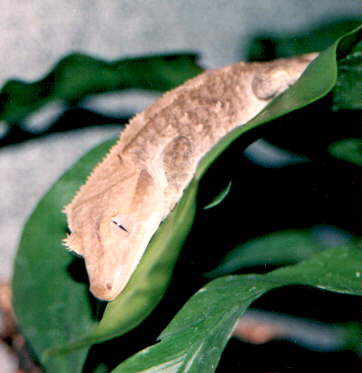|
by Petra Spiess 
Introduction The New Caledonian crested gecko, (R. ciliatus) was thought to be extinct until the early 1990's when two independent research groups "rediscovered" this species living quite happily, and in relatively large numbers, on the islands of New Caledonia. Since that time, many wild caught R. ciliatus have been brought into the United States and have produced many captive bred offspring. Crested geckos thrive in captivity, they are easy to care for and breed readily. Crested geckos are a medium sized, stocky gecko species. The head is very large relative to the body and is "flattened". Two lines of "frills" run across either side of the head, over the eyes (giving the appearance of "eyelashes") and down the body. The SVL is approx 5-6 inches. Crested geckos have adhesive lamellae and have an interesting additional adhesive lamellae pad on the tip of the tail. Body coloration is variable but tends to be some shade of yellow, red, or orange. Some individuals have black spots over their bodies.Captive Care Crested geckos are by far one of the easiest geckos species to maintain in captivity. They thrive at a temperature range of 70-85 degrees, and generally (except in very cold climates) do not require supplemental heating. They do not require full spectrum lighting as they are nocturnal and spend the daytime hiding in crevices. A pair or trio can be housed in an enclosure of these minimum dimensions: 1 ft x 1 ft x 2 ft. (l x w x h). Crested geckos are arboreal and prefer enclosures with a vertical format. I house my animals in cages manufactured by Vision Herpetological, which I have found ideally suited to crested geckos as there is a perfectly sized "crevice" running around the inside front section of the cage where the geckos hide during the day. Diet includes fruit flavored baby food such as peach and apricot and live prey such as crickets, mealworms, cockroaches, and flies. The baby food in presented in a silver dollar sized section on the top of a deli cup lid. Calcium supplement is mixed in with the baby food mixture once a week, and the insects are also lightly powdered with calcium supplement once a week. Other keepers have raised several generations of crested geckos without any live prey items at all, instead, they offered only fruit and meat type baby food mixtures supplemented with vitamins. Crested geckos are avid eaters and are offered 5-6 live prey items each, alternating with baby food. The geckos are misted every evening to keep the relative humidity between 50-80 percent. Different substrates can be used with crested geckos such as orchid bark, newspaper, and paper towels. I use paper towels because they are cheap and easy to clean, but they are not exactly aesthetically pleasing. Breeding Crested geckos are prolific breeders, generally producing between 10-20 clutches a year of two eggs each. The number of clutches depends on a variety of factors including: the age of the female, the quality of the diet, and most importantly, temperature. In fact, the only way to get this geckos to stop breeding is to lower the cage temperature to between 50-60 degrees F for a few months and reduce the amount of food offered. Crested geckos are generally sexually mature at about 8 months, but I have found that females of at least 12 months of age are more reliable breeders and produce larger clutches with a greater percentage of fertile eggs. Crested geckos are difficult to sex as babies, but as they mature, the males develop a LARGE hemipenal pouch under the base of the tail and are easily distinguished from females that lack this appendage. This bulge becomes very noticeable about 4-6 months of age. A cycling period is recommended to promote breeding, 3-4 months with a cage temperature of 50-60 degrees seems to work well for me. After the cooling period, the daytime high should be allowed to reach into the 80's and the nighttime low can drop into the low 70's or high 60's. Increasing misting at this time may also promote breeding activity. It is not easy to distinguish developing eggs in the abdomens of gravid female crested geckos like it is in other gecko species such as leopard geckos. However, gravid females do exhibit a slight bulge in the lower abdomen prior to oviposition, but you have to look carefully. Oviposition occurs in loose, moist substrate on the floor of the cage. In my enclosures, I provide one section that is a mixture of peat moss and vermiculite which is kept moist at all times. Other breeders have found that crested geckos will utilize open containers of moist loose substrates. Eggs can be incubated from 70-80 degrees F, but temperatures above 82 degrees should be avoided for extended periods. Babies hatch between 65-80 days, depending upon temperature. Babies are small but hardy and do well housed in small aquariums (5 to 10gal) with screen lids. Babies will eat after the first shed (sometimes before depending upon the individual) and should be offered small crickets and baby food. |
Recent Crested Gecko Classifieds: |